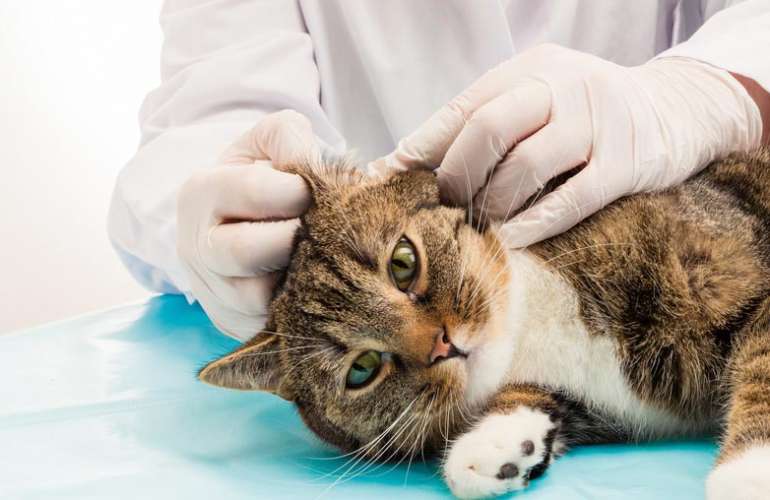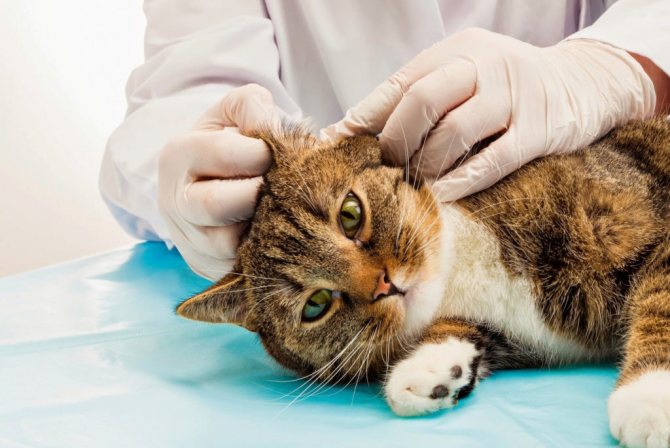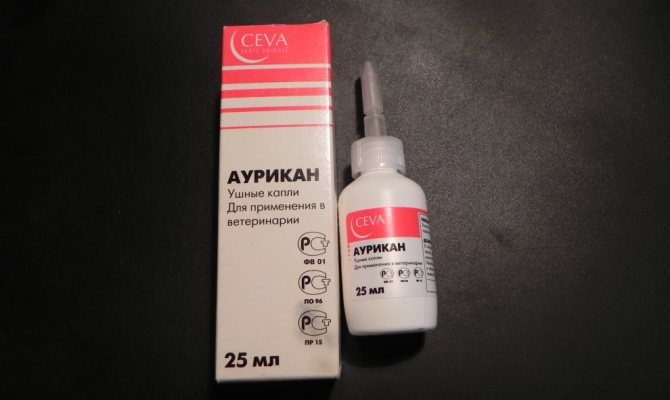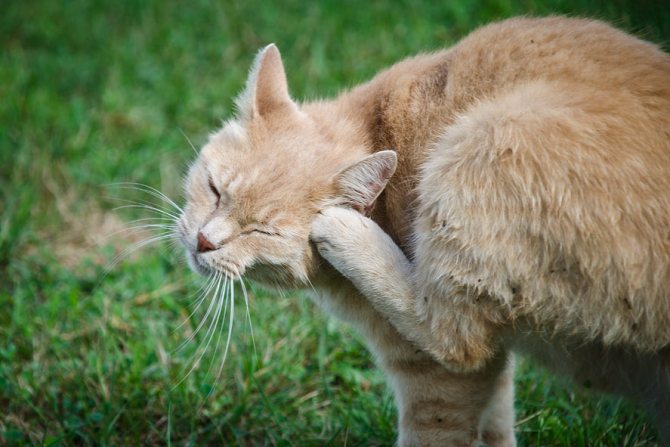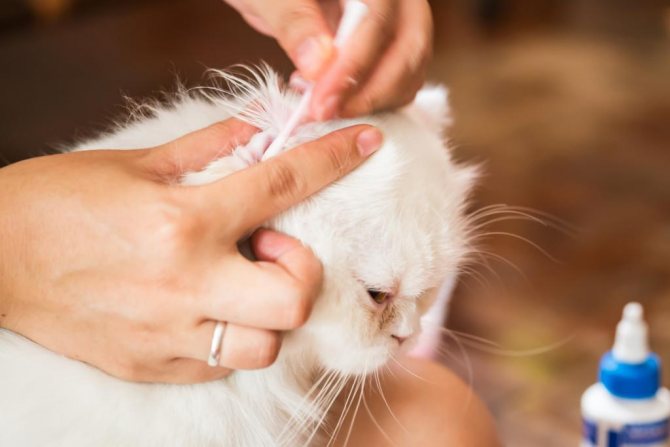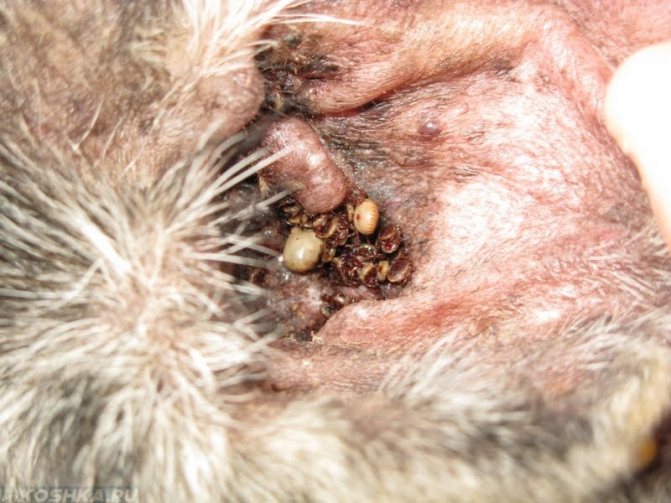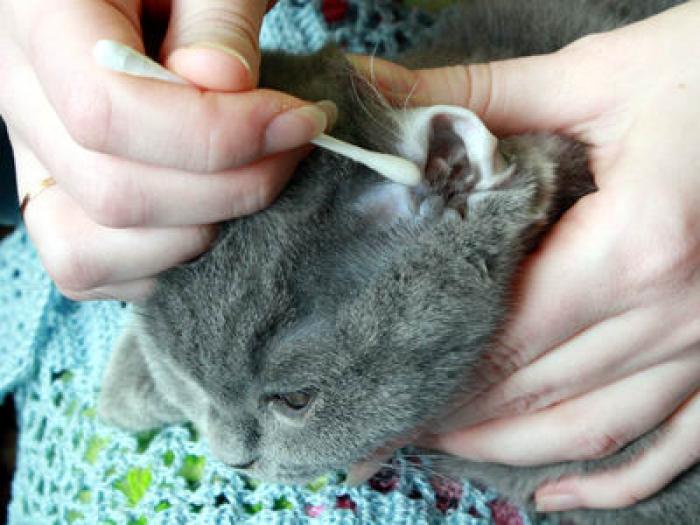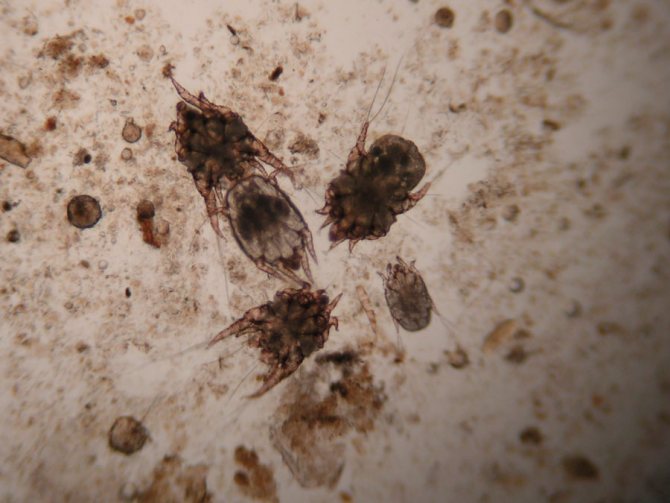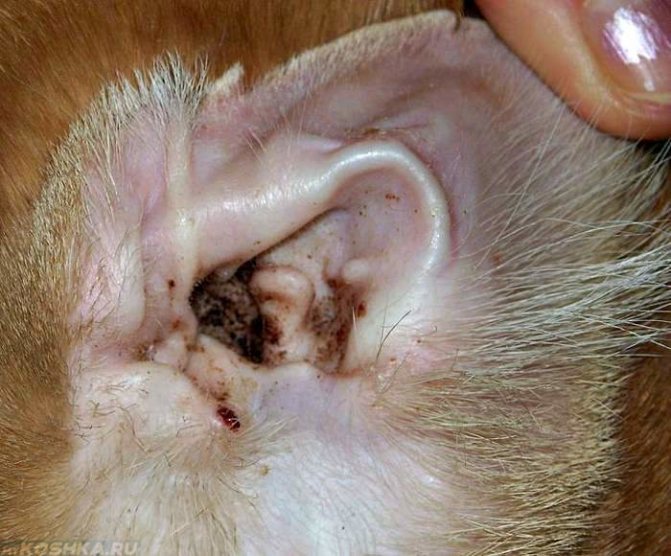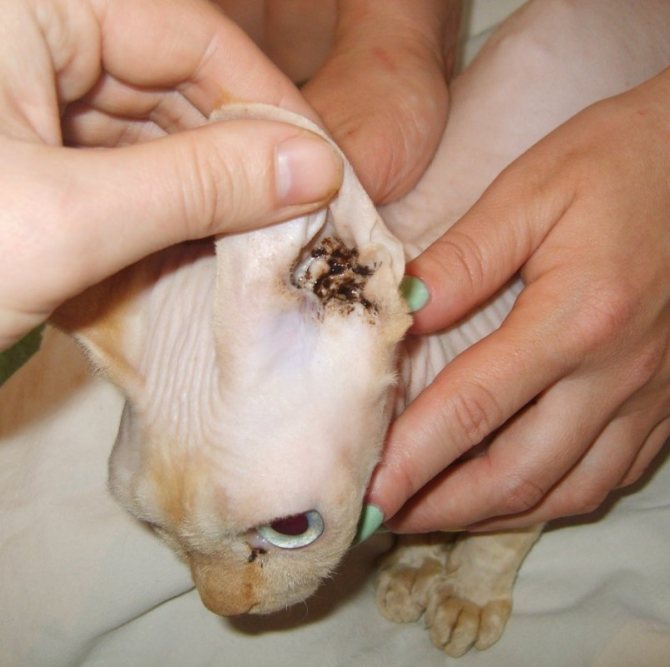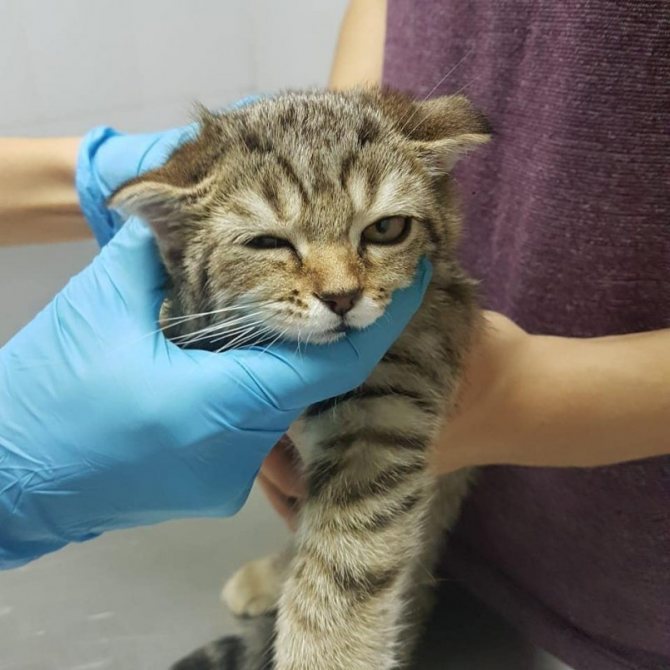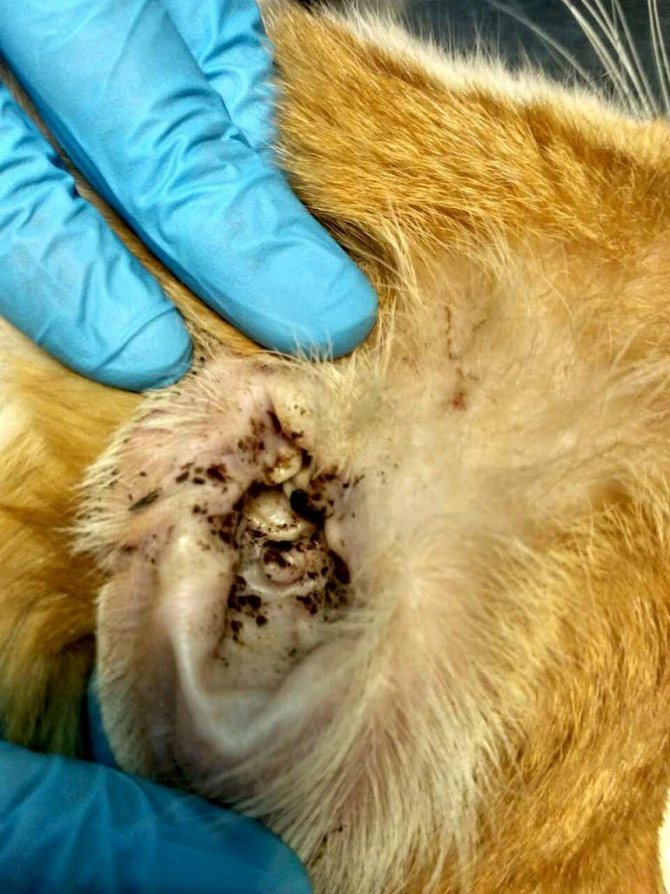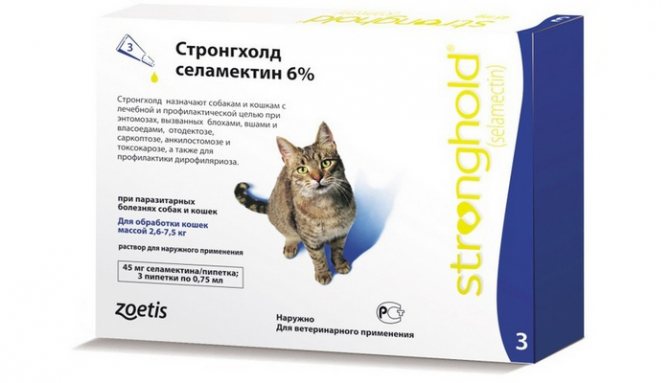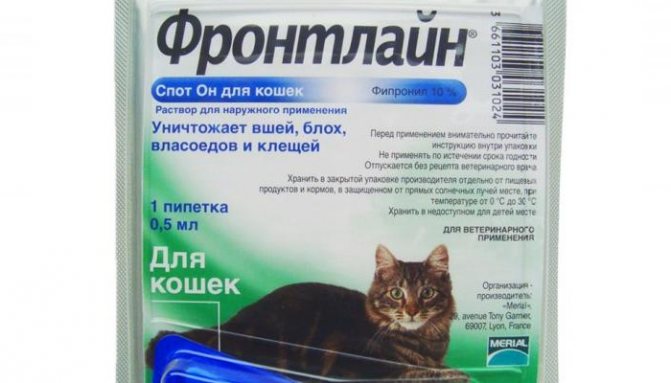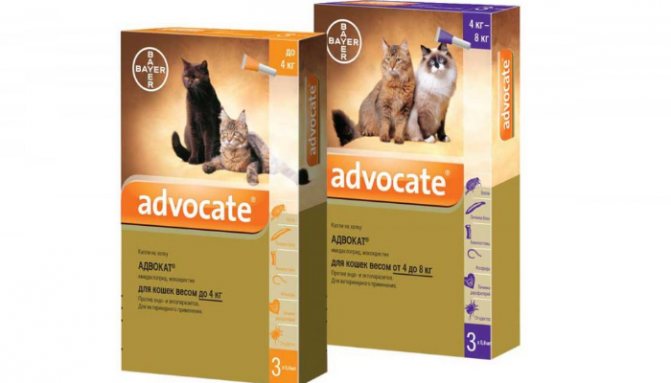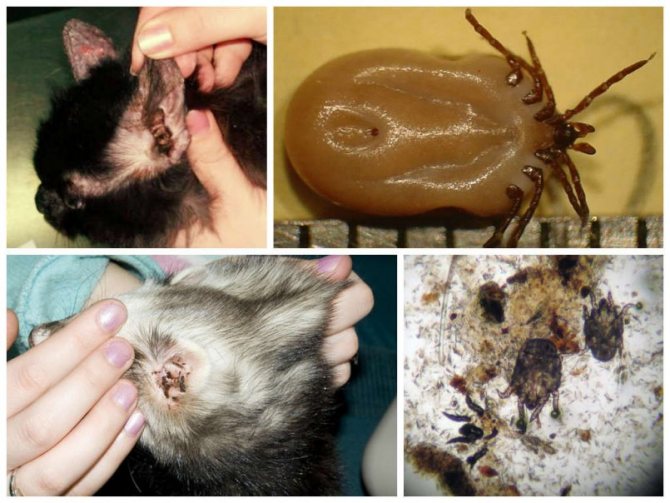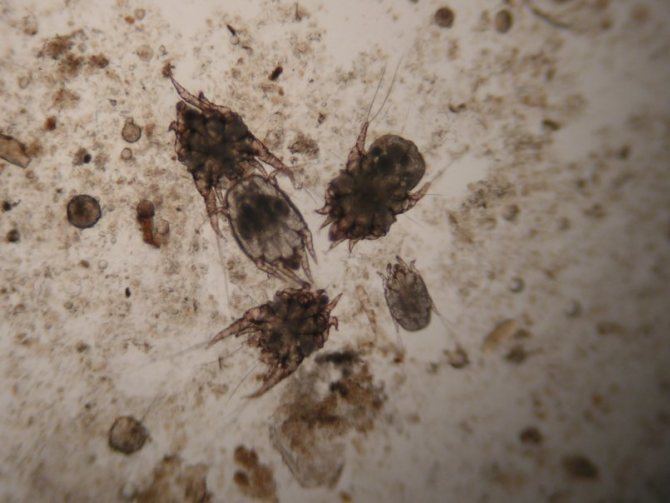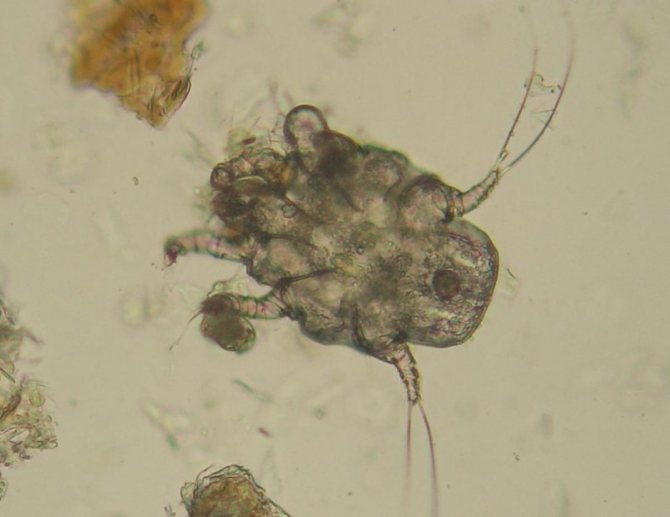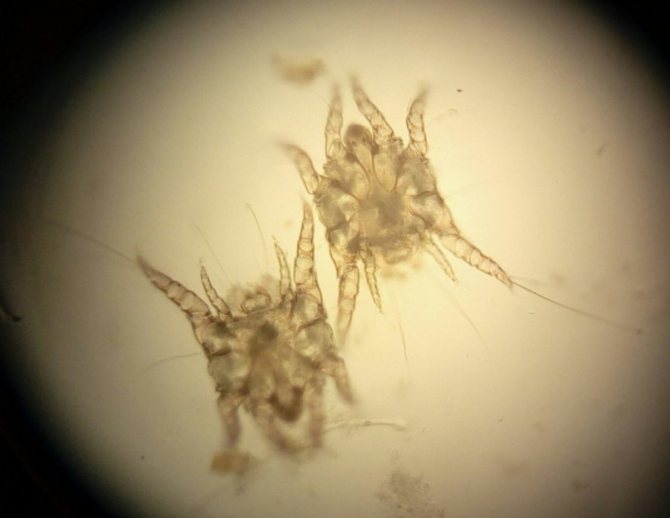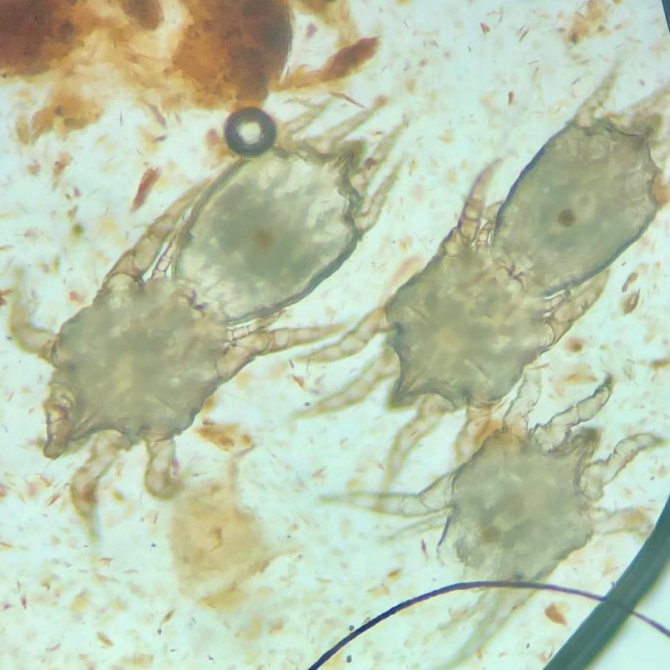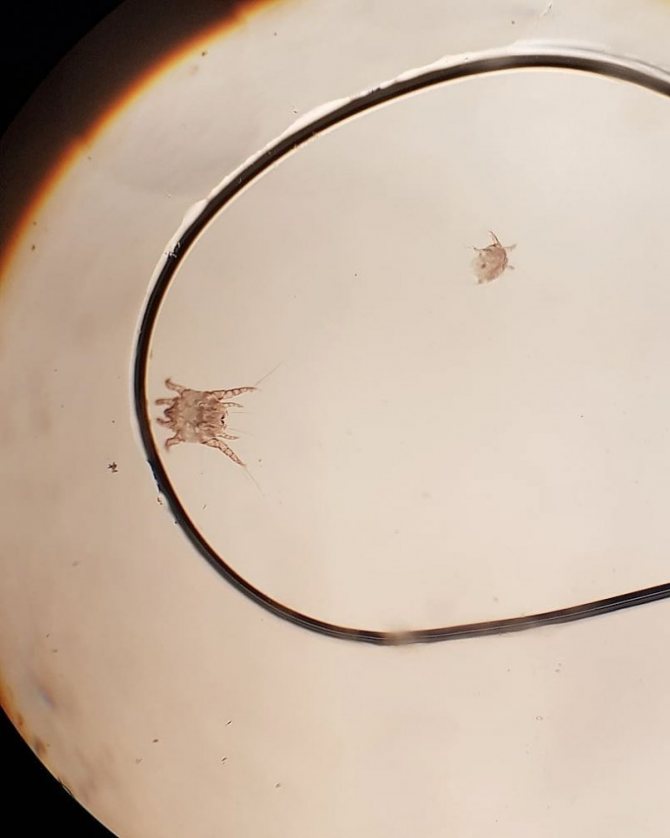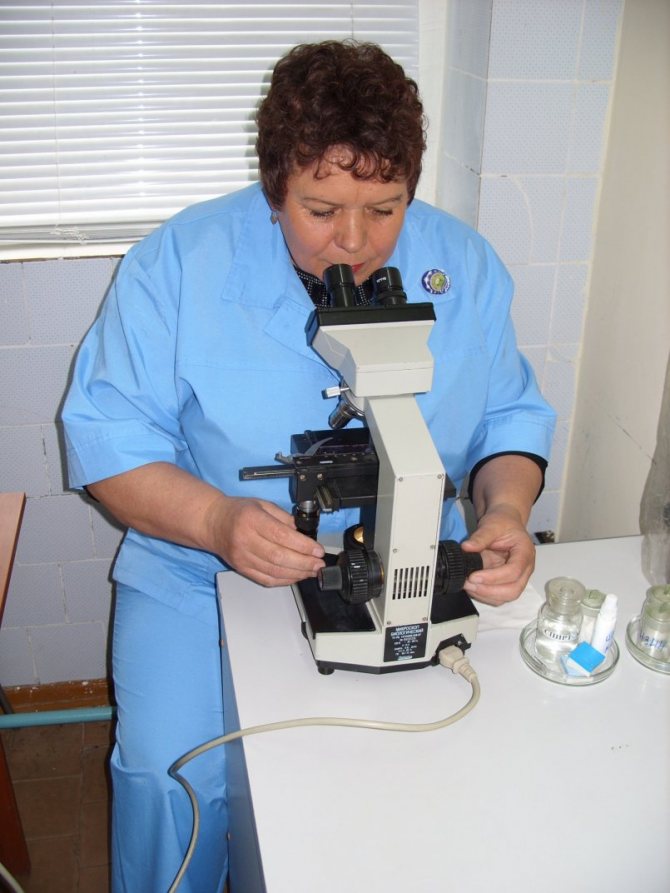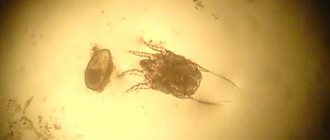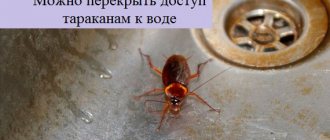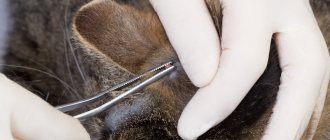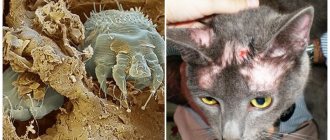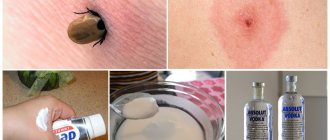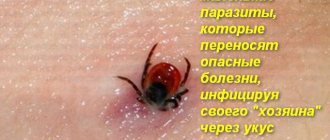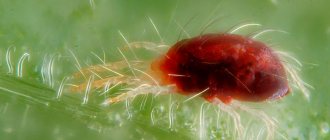Otodectosis is a disease that is caused by mites parasitizing in the auricle. The causative agent of this type of acariasis is Otodectos cynotis, a representative of the suborder Psoroptidia. In cats, young individuals are more susceptible to otodectosis. If untreated, the animal may develop otitis externa or otitis media, in advanced cases - rupture of the tympanic membrane, partial or complete hearing loss, inflammation of the lining of the brain.
Otodectosis in cats
Otodectosis or ear scabies - Chronic invasive disease of cats caused by parasitism of the otodectotic mite on the inner surface of the auricles and in the external auditory canal.
Dogs and fur-bearing animals also suffer from otodectosis.
The causative agent O. cynotis is a flat, oval, off-white body 0.3–0.7 mm long. The length of females reaches 0.7mm, males - up to 0.6mm. Their maximum width is 0.47-0.55 mm. The tick has four pairs of legs, females have three pairs, the fourth is rudimentary. Suckers in females are located on the 1st and 2nd pair of limbs, in males on all four. The tick has a gnawing mouth apparatus. The otodectose mite lives on the surface of the skin and feeds on exfoliated cells of the epidermis, scales and dry skin crusts. The females of the otodectic mite lay from several tens to hundreds of eggs during their life.
The development cycle of an otodectotic tick: egg, larva, protonymph, teleonymph, adult tick. Under favorable conditions, the entire development cycle of the tick lasts 18-25 days.
Epizootology... Young animals aged 1.5 to 12 months are more likely to get sick. Otodectosis has no seasonality, a cat can become infected at any time of the year, but more often the infection occurs in the warm season because the parasite lasts longer in the external environment. A cat becomes infected from an animal with ear scabies through direct contact, through care items, and people can carry ticks.
Pathogenesis... Ticks have a mechanical and toxic effect on the skin of the auricle, resulting in irritation of the waste products of the tick's nerve endings, destruction of the epidermis, and atrophy of the sebaceous glands. The mites, by their mechanical action, peel off the upper layer of the epidermis, and tissue fluid is released from the damaged areas of the skin, which dries up and forms scabs and crusts. When the secondary microflora is introduced into the damaged sites, an inflammatory process develops in a cat, sometimes a perforation of the eardrum occurs and the inflammatory process passes to the middle and inner ear. Sometimes the transition of the inflammatory process to the meninges is possible and the cat develops meningitis, the sick cat quickly dies.
Clinical picture... At the onset of the disease, a sick animal develops a slight itching, a sick cat begins to worry, shake its head, strive to comb the ear affected by the tick with the claws of its paws, or scratch the sick ear on various objects. During a clinical examination of such a sick cat, a veterinarian establishes inflammation of the ear canal, a serous, and sometimes purulent and ichorous exudate, which has a sharp putrid odor, is released from the ear canal.Sometimes the exudate completely clogs the ear canal and this leads to hearing loss. The exudate released from the ear canal sticks together the hair of the lower edge of the auricle and, drying out, forms scabs and crusts of gray or light brown color. Sometimes, if you lightly press on the base of the auricle, you can hear a characteristic splash.
When the eardrum is perforated, the cat loses appetite, the body temperature rises, we notice curvature (the head is turned towards the affected ear), nervous phenomena appear, up to convulsions.
Diagnosis... The veterinary specialist makes the diagnosis of otodectosis on the basis of the clinical symptoms of the disease and the results of microscopic examination of scrapings from the inner surface of the auricles for the presence of a tick. To do this, the scales and crusts of scrapings from the affected area are poured with several drops of kerosene (the scraping is examined on a glass slide), covered with another glass slide, which is pressed with fingers several times, moving along the slide, and examined under a microscope or magnifying glass.
Differential diagnosis... When conducting differential diagnostics, a veterinarian must exclude otitis media of microbial origin (streptococcosis in dogs and cats), food allergies (food allergies in animals), otitis media of fungal origin (melacesiosis).
Treatment... Currently, there are a large number of antiparasitic drugs to combat otodectosis. These can be solutions, ointments, powders, aerosols, gels. In case of a severe course of the disease, the veterinary specialist has to prescribe acaricidal preparations to the sick animal intramuscularly. The process of treating otodectosis in a cat itself takes place in 3 stages:
- cleaning the ear canal;
- the use of acaricidal drugs;
- maintaining the sick animal immunity.
The cleaning of the ear canal in a sick cat is carried out mechanically - the areas of the auricle infected with a tick are cleaned, in which larvae, hardened crusts, scabs, exudate are removed. When carrying out mechanical cleaning, disinfectants are used (3% hydrogen peroxide, solutions of furacillin, potassium permanganate, camphor alcohol, etc.).
After cleaning, the affected areas are treated with acaricidal preparations (otoferanol, acaromectin, ivermectin, stronghold) by injecting a few drops into the ear canal. So that the injected acaricidal preparation is evenly distributed, we massage the auricle with our hands. The pharmaceutical industry produces a large number of acaricidal ear drops "Amit", "Amitrazin", "Dekta", "Tsipam", "Demos", "Ectodes", "Enatsid-alpha", "Dana", "Mikodemocid", "Otovedin", "Surolan", "Otoferonol -gold", "Otoferonol-plus", "Otoferonol-premium", "Aurikan", "Anandin-plus". For ease of use, acaricidal drops are produced in pipettes - "Dana", "Frontline", "Fiprist".
For the treatment and prevention of otodectosis in cats, 0.2-0.3 ml of acaricide heated to 30-35 ° C is injected into each auricle. For a more complete treatment with acaricide of the entire surface of the auricle and the auditory canal, fold the auricle in half using a 2-gram syringe, connect it to the Agali tap. Instead of a needle, a rubber tube 3-4 cm long is attached. For treatment, oil formulations of hexachloran - crealin preparations with a content of 0.03% gamma -isomer (hexaline, hexataine) are used. To prepare a working emulsion from hexaline and hexataine, it is required to take 5 g of the drug per 100 ml of oil. For treatment, you can use 40-50% oil suspension of phenothiazine, 5% oil suspension of Gordon, 0.5% composition of cyodin on water or oil, 0.1% oil emulsions of Dursbon, Sebacil (foxim).
Gels (Ivermek-gel, etc.) and ointments (Aversectin, etc.) are placed in both ears, even if one ear is affected by sarcoptic infestation.
In severe cases, with great caution (highly toxic) ivermectin. Drugs are used in the form of drops, which include amitrazine.
To increase the immune system of a cat with otodectosis, immunomodulators (immunofan, ribotan and others) are used. Prescribe vitamin preparations (gamavit) and vitamin complexes inside. Feeding a sick animal should be complete and balanced. In the presence of concomitant diseases, it is advisable to take antibacterial drugs inside after preliminary titration for sensitivity in the veterinary laboratory.
Features of tick lesions
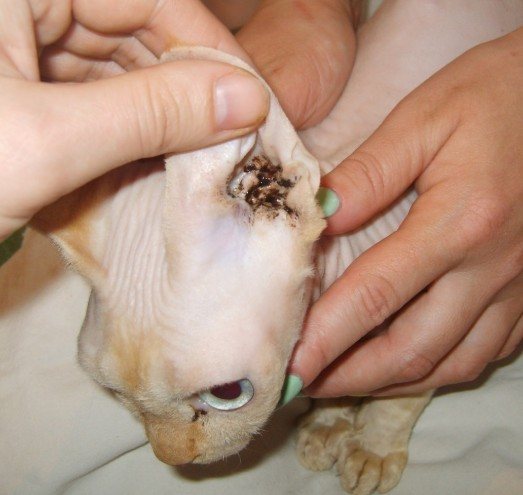
Ear mite in a cat It is possible to identify a disease in a pet by its characteristic signs, since insects infect both ears at the same time. The provoking factors of their spread are moisture and heat.
When the ear canal is damaged, an inflammatory process occurs, which contributes to the abundant secretion of pus. This causes serious discomfort to the pet, and the discomfort is annoying all the time.
To identify the disease, it is enough to observe the behavior of the cat, check the ears for the presence of waste products of the parasite.
Characteristic signs of illness affecting behavior:
- the cat becomes restless, cannot lie in one place;
- periodically shakes his head, meows plaintively;
- presses against the owner, tilting his head to the side;
- periodically scratches ears on corners and furniture.
Infection can also be detected by the presence of purulent discharge that accumulates in the auricle, and by the characteristic brown crusts directly in or near the ear.
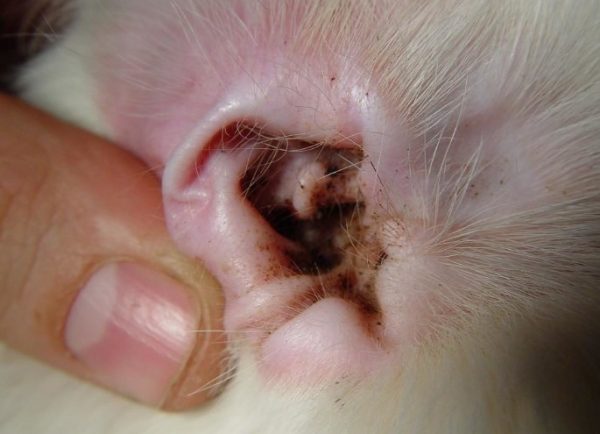

You can also detect infection by the presence of purulent discharge.
Lack of treatment leads to the penetration of the pathological process into the middle and inner ear, then the disease switches to the lining of the brain, which threatens with serious health complications.
Symptoms of an advanced form of otodectosis:
- high temperature;
- dejected state;
- the head is constantly tilted towards the affected auricle;
- periodic seizures.


Be sure to read:
Dironet Spot-on ® (drops) for cats and dogs to eliminate ticks and fleas
A neglected form of the disease can cause death, so it is necessary to check the ears of the animal and respond in time to the unusual behavior of your pet.
An ear mite is an arthropod insect that infects an animal by settling in its auricles. The fact is that there is an ideal environment for him to live in - warm and humid. The cycle of development of the parasite from larva to death is about 15-20 days. In the external environment, he can live much longer, however, not finding the opportunity to settle and reproduce, the parasite dies.
A domestic cat can become infected in several ways:
- through contact with an infected animal, if it goes out for a walk;
Fortunately for humans, the tick does not parasitize on it, however, having contact with other pets, a person can become a carrier of the parasite.
The treatment of a pet for an ear mite must be approached in a comprehensive manner:
- cleansing the auricle from ticks and their waste products mechanically - this reduces their number and promotes recovery;
When choosing a drug or agent to combat ticks, it is necessary to complete the entire course of treatment, otherwise the disease will return soon.
In most cases, the appearance of a tick is indicated by obvious changes in the character of the animal: the cat begins to shake its head and comb its ears with its hind legs. To verify the presence of parasites, you need to examine your pet's ears for:
- redness of the skin, especially in the folds (most often parasites accumulate in these places);
- waste mites - brown plaque with an unnatural odor;
- increasing the amount of earwax.
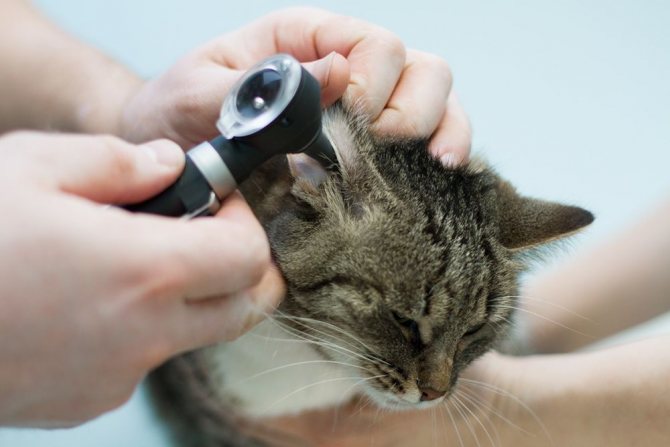

Important. Lack of treatment leads to the further spread of the inflammatory process: to the meninges, middle and inner ear. In this case, otodectosis is accompanied by an increase in body temperature, depression, curvature and seizures, which ultimately leads to the death of the pet.
Combing your ears can be a symptom of other conditions. Before starting treatment, make sure you are dealing with otodectosis.
Otodectosis in cats (ear scabies): causes, symptoms and treatment
Otodectosis in cats is a common disease, especially in kittens and young animals that walk freely on the street. This disease is also called ear scabies, since the mite that causes it lives in the ears of the cat and creates itching that is difficult to tolerate. The ear mite overtakes not only cats, but also dogs, ferrets, foxes, is widespread and overtakes not only street cats, but also quite domestic ones, since it is possible to bring a microscopic pathogen on clothes, shoes, hands and infect a cat. What should you know about this tick and the characteristics of the disease in order not to miss the suffering of your pet?
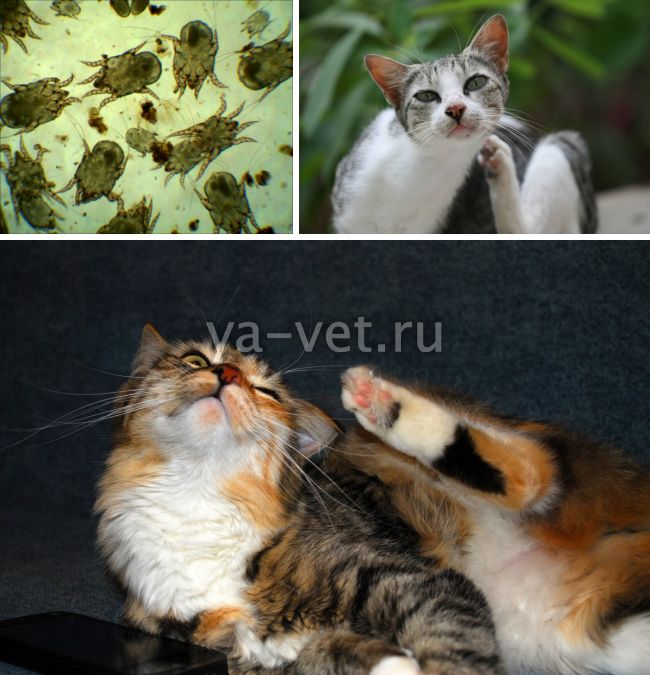

Otodectosis Is a parasitic disease that causes mite of the kind Otodectes cynotis... Its small size is only half a millimeter
do not allow the owners of the cat to notice it during a routine examination. Traces of its vital activity become noticeable when it gets on the skin of the outer ear,
a tick in search of food damages the upper layers of the skin
... In its development, the tick goes through five stages over about 40 days of life and is able to reproduce only in the ears of the cat. Microscopic lesions, abundantly moistened with tick saliva and other chemicals, create an unbearable irritant effect, provoking the cat's behavior characteristic of the disease.
Ear scabies in cats - symptoms
Main a sign of ear scabies in cats - itching in the ears, which provokes the appearance of this behavior:
- The cat has itchy ears. Even touching his ear, the owner makes him move his paw in an attempt to scratch.
- The cat shakes its head tensely.
- She tries to rub her ears against any surface.
When viewed inside the ear, you can see an accumulation of a viscous mass that looks like earwax, but is darker in color and has a rather unpleasant odor.
Stages of development
Since disease is long
which easily turns into
chronic
, it requires immediate treatment, since
cannot pass by itself
.
- In view of this, otodectic mange in cats is divided into three stages:
- The first two weeks from infection. The cat behaves as usual, only sometimes you can notice that it shakes its head and ears more often and more diligently. By examining the inside of the ear, you can see severe redness and accumulation of ear secretions. This means that the ticks are already breeding and the first generation of offspring will soon begin to appear.
- The third week of infection is characterized by the appearance of a brown, foul-smelling mass in the ear canals. The cat is already actively rubbing its ears against everything, eats poorly, the coat fades and sheds. Ticks can already be seen under the microscope
- This period lasts up to about 40 days after infection, the ear fills with viscous secretions and dry crusts. When touching the ear, the cat tries to scratch it with its paw. The animal does not find a place for itself, trying to get rid of the itching.
- Combed skin damaged by ticks becomes infected with streptococci and staphylococci, which cause pathological inflammatory processes in the middle, inner ear and further in the meninges. This option in cats occurs mainly with prolonged malnutrition and poor grooming.
- More often, the disease becomes chronic, which exhausts the cat to complete exhaustion and death.
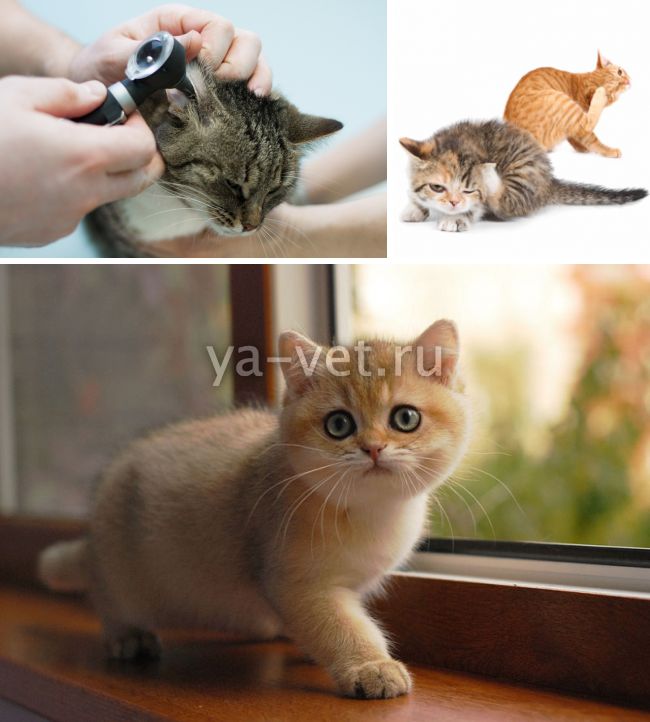

What complications can be caused by otodecosis in cats?
If a ear scabiesstriking cats continues evolve in time up to three months, the following complications become real:
Symptoms
Due to its microscopic size, it is difficult to visually detect the Otodectos cynotis tick. But you can see their waste products, which form moist brown crusts with an unpleasant odor inside the auricle. With a large number of ticks in a cat, in places of their accumulation, you can sometimes notice some kind of movement.
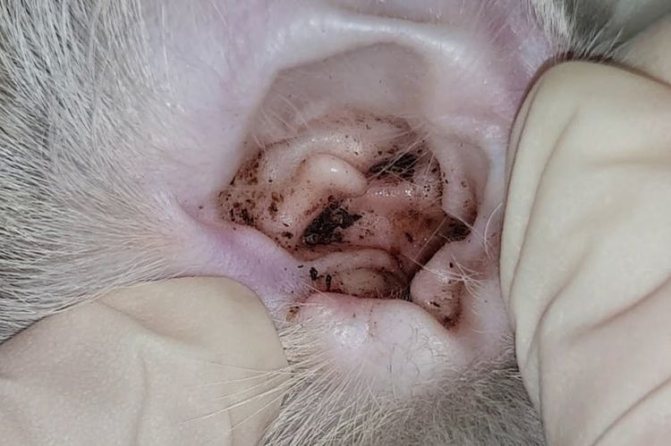

Signs indicating the presence of a tick-borne infestation include:
- Indomitable itching that occurs as a result of an allergic reaction to the saliva and feces of the parasite.
- Redness and swelling of the auricle.
- Scabs from which serous or purulent exudate is abundantly secreted. With an advanced disease, they are able to completely clog the ear canal.
- The animal constantly keeps its head tilted to one side.
- Due to constant scratching, mats may appear on the cat's head.
- Increased pain sensitivity in the ears and head.
- The cat becomes restless, may refuse to eat, and may have a fever.
- In some cases, alopecia (local baldness) may develop as a result of otodectosis.
Treatment and diagnostics
Unlike other diseases, diagnosis of otodectosis it's easy to put. Clinical symptoms and laboratory tests allow this to be done quickly and accurately. It is possible to distinguish ear scabies from other parasitic diseases by the primary damage to the ears of a sick animal. In the veterinary clinic, this diagnosis will be made or excluded thanks to a professional taking and examining scrapings under a microscope.
With regard to treatment, there are two approaches and both have been used with success.
External treatment - application to the skin in the lesion focus of liniment, drops and ointments.
Internal - in the form of subcutaneous injections with acaricidal drugs. Often they are combined in severe cases of the disease, which allows the cat to heal faster.
Before applying the medicine
, the ear must be rinsed and cleaned of the waste products of mites, crusts, scabs. This is done with hydrogen peroxide, furacilin, or a special veterinary solution. It is advisable to do this with a helper or swaddling the cat so that it does not hurt you.
Subject to the treatment regimen, depending on the neglect of the disease, after two to three weeks, you can relieve the cat of all symptoms of ear mites.
Remember that among all cats admitted to veterinarians with a primary diagnosis of otitis media, the overwhelming majority are also diagnosed with otodectosis, which caused ear inflammation. The favorite target of the disease is a kitten from one to four months. There were cases when they acquired a baby already infected with a tick. Therefore, be alert to any changes in your pet's well-being and behavior.
As soon as the cat starts to itch, worry, or lose appetite, contact your veterinarian. He will help you with the diagnosis, prescribe treatment and accompany your pet until complete recovery. In ours you will not only get the help of a qualified veterinary dermatologist, but you will also be able to purchase medicines at low prices thanks to direct purchases from the manufacturer. Monitoring the treatment by a veterinarian is the key to the successful treatment of your pet! And don't let your pet otodectosis in cats.
If you find an error, please select a piece of text and press Ctrl + Enter.
Treatment process
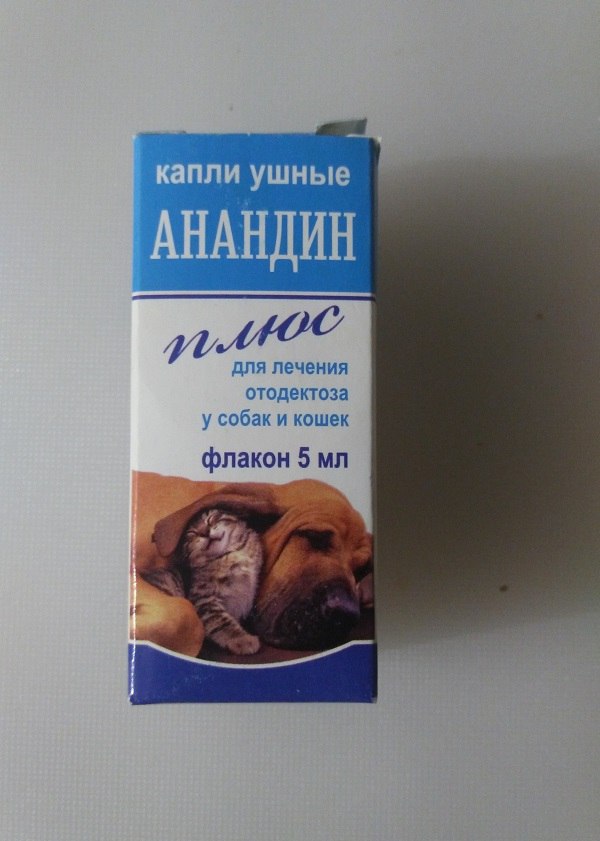

Isolating a cat in a bathroom where its tray is installed
You can get rid of parasites at home, but the treatment process will be long, regardless of the drugs used.
On average, it takes 30 days to completely get rid of the disease.
In order to do this you will need:
- isolate your pet from contact with other animals and children;
- wash hands after contact with an animal;
- use gloves when treating the cat's ears;
- use special drugs, including folk remedies.
Home treatment involves the use of specialized medications, but it must be remembered that they must be used strictly according to the instructions or recommendations of a doctor.


The treatment process includes the daily process of cleansing the ear of the cat from the wax. For this, it is best to moisten cotton wool in hydrogen peroxide. The use of a special collar is a mandatory element of treatment. It allows you to ensure good treatment of the areas affected by the tick, will not allow the cat to comb his ears, which will speed up the healing process.
Antihistamines should be used to relieve itching. After the main symptoms have passed, the medication should be continued for about a week.
Ear mite in a cat - its symptoms and treatment
The ear mite in cats is a tiny parasite that causes the animal a lot of suffering and discomfort. Each ear mite has a life cycle that lasts about three weeks. They can cause irritation and inflammation, and can also lead to infections in both the outer ear and the inner ear canal.
There are several different types of ear mites that parasitize cats, but the most common is Otodectes cynotis. These are mites that feed on the oils and waxes found in the ears of the animal. Parasites cause a serious illness called otodectosis. To relieve the animal from torment, it is important to react in time and start treatment.
Ear treatment rules
How to treat ear mites in cats at home? The photos clearly show how to properly handle and bury the affected ears. However, in reality, everything can be more complicated if the cat protests and breaks out. In this case, it is recommended to swaddle her, like a baby, in a towel or blanket, so that only the head of the animal remains outside. Being in this position, the cat will not be able to interfere with the high-quality processing of the ears.
In addition, it is very important to clean the ear as thoroughly as possible from the waste products of arthropod parasites, since otherwise the effectiveness of the medicine is significantly reduced.
Ear mite
The ear mite in cats is a tiny, tenacious arthropod. Before puberty, the parasite has time to shed several times (sheds a rough shell). Microscopic jaws firmly dig into the skin and suck out the intercellular fluid.
What does an ear mite look like:
- length - 0.2-0.6 mm (the size of a semolina grain);
- body shape - oval;
- color - yellow;
- eight limbs and two pedipalps.
Many owners have a question, whether an ear mite in cats is not transmitted to humans, or not? In fact, the parasite does not pose any danger to humans. Ear mites of cats are dangerous for dogs, hamsters, decorative rabbits. They also take up residence in the ears of the animal and cause severe discomfort.
Medicines for ear mites in cats will be prescribed by a veterinarian after diagnosis. The main thing is to contact a specialist in time, since untimely treatment can lead to hearing impairment in a pet.
Find out also about
subcutaneous tick in cats, the symptoms of its presence and the order of treatment.
Choice of remedies
The most effective, therefore, common among cat lovers and often used method of treatment is local.
For this, it is best to use ear drops from an ear mite. They not only eliminate parasites, but also act on pathogenic bacteria that appear during inflammation. The main requirement: the spectrum of action should extend to parasites related to Otodectes cynotis.
Pus in the ear
Pus in a cat's ear
In the event that the disease has reached the stage of the appearance of pus in the cat's ear, then the remedy for ticks should be of a wide spectrum of action. It is best to use drops that eliminate fungi and bacteria. You can also use drugs with a narrow spectrum of action, but additionally use an antifungal drug, for example, an ointment, since it remains on the skin for a long time.
If you use lotions and sprays for disinfection while cleaning your ears, it is best to warm the formulations to room temperature before the procedure.After applying the agent chosen for treatment to the inside of the ear, this area should be lightly massaged. Then you need the cat to shake his head, after which you can clean the ears from the wax.
Immunostimulants
An effective way of treatment is the use of special injections, immunostimulants. An important condition: do not use preparations containing alcohol for this.
The products must be designed specifically for the treatment of cats, and compliance with the instructions is a prerequisite for successful treatment.
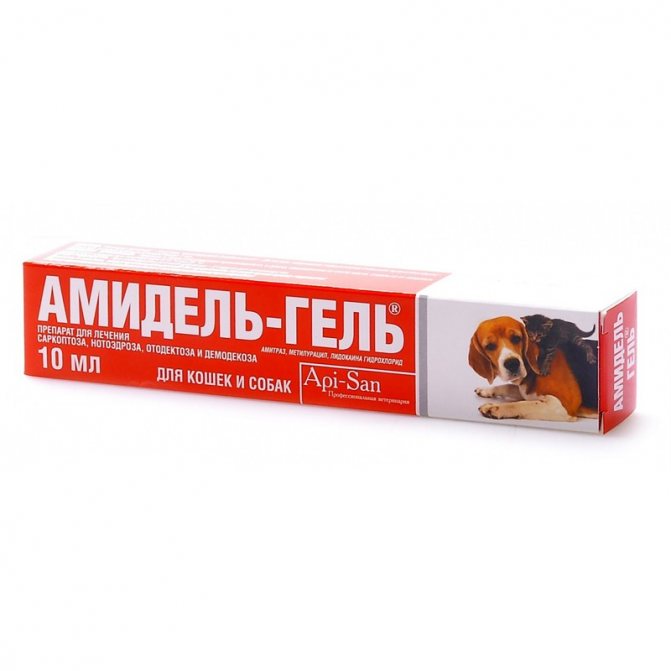

Exceeding the terms, dosages must be agreed with the veterinarian, you cannot do this on your own. In the event that, after completing the course of taking the drug, a brown plaque appears in the ears, then further treatment should be carried out with antifungal agents. Drops should be excluded from therapy.
Ear mite symptoms
Signs of ear mites in cats:
- excessive scratching of the affected ear;
- hair loss;
- waxy discharge appears;
- inflammation and itching;
- trash that looks like coffee grounds
- scabs or scratches around the ears;
- disorientation.
The main symptoms of otodectosis are hard to miss. The animal becomes nervous, constantly shakes its head, while it can meow loudly and pitifully. The head will tilt towards the affected ear during scabies.
If you notice such signs, you need to contact your veterinarian. An ear mite in cats whose symptoms may not appear immediately, can be dangerous to the health and life of your pet (the disease leads to inflammatory processes in the membranes of the brain, after which painful death occurs). Symptoms and treatment must be constantly monitored to prevent complications.
Features of the course of otodectosis: signs of tick infection
To cleanse the ear canal, prepare cotton swabs, a specialized tool for softening dried ear discharge and a towel for fixation. Cats do not tolerate violence, so the operator who is cleaning their ears must take care of their own safety.
The defeat of the ears with otodectosis
If the instructions for use of the drug provide for using it as a means for softening the crusts, additional agents will not be required. The effectiveness of treatment is determined by the presence of a tick in the skin scraping in combination with clinical symptoms. One medication is chosen for treatment. It is prohibited to use two medicines containing acaricides.
The disease can be determined by the following symptoms:
- The behavior of the cat changes markedly - the animal often begins to shake its head, comb its ears until it bleeds.
How to treat ear mites in cats when these symptoms are found?
Otodectes cynotis disease of the external ear caused by microscopic parasites is known by such names as otodectosis in cats, parasitic otitis media, ear scabies, ear mites.
In the beginning, one ear is most often affected, then the disease spreads to the other. Also, with otodectosis of a cat, the parasite is able to settle in other areas: neck, tail, pelvic area. This is because the animal curls up into a ball when it sleeps. Outwardly, it may look like dermatitis, allergies, flea bites.
Under good conditions of detention, proper nutrition, regular cleaning of the ears, otodectosis in some cases remains unnoticed by the host and is asymptomatic. However, with deterioration of conditions of detention, with unbalanced feeding, weakening of immunity, ear mites can go into the active stage. Then the disease is acutely showing characteristic symptoms and treatment directly depends on the condition of the "patient".
In kittens and young animals, the disease is severe. The kitten becomes infected especially quickly from other animals and from the mother.
To feed, the parasite injures the skin of the animal, from which a liquid is released, which serves as food for it.Such microtrauma, as well as the secretion and excrement released in the process of vital activity, irritate the skin and cause severe, unbearable itching. To alleviate the condition, the animal constantly shakes its head, scratches its ears with its paw, rubs them against objects.
Due to mechanical damage to the skin on the back of the head and ears, scratches, abrasions are found, and lesions with bald patches may appear. If the eardrum is affected, the pet tilts its head to one side.
If untreated, the condition worsens, inflammation gradually develops - otitis media. Therefore, otodectosis is also called parasitic otitis media.
Over time, the inner surface of the ears turns red, the skin in this place thickens, gathers in folds. If the process is not stopped, the inflammation goes to the eardrum, the inner ear and further penetrates into the brain. In this state, the pet's body temperature rises, lethargy, convulsions or seizures appear.
The behavior of the animal changes:
- sudden movements appear, running to nowhere;
- meowing when scratching the ears;
- the cat presses the ears, does not allow stroking itself on the head and touching the ears.
The owner, in order to understand what is happening with the cat, needs to examine the ears. It will not work to consider parasites. But the signs of an ear mite in cats are immediately clear - an atypical color of plaque and severe itching.
If normal sulfur in cats is light with shades of yellow or brown, then with otodectosis, the contents of the ear are dark brown and even black, resembling coffee grounds (as in the photo below). At the same time, sulfur is of different consistency: dry, wet, loose, solid, pasty.
In the presence of an inflammatory process, an unpleasant odor emanates from the ear.
In the veterinary clinic, the diagnosis is made on the basis of examination and examination of the contents of the ear under a microscope.
Basic methods:
- With the help of a special instrument, the doctor sees the moving white dots.
- Examining sulfur under a microscope allows you to see adults, larvae and eggs.
- Positive ear method. The doctor wipes the auditory canal, and the cat reacts to this by scratching with its hind paw.
If inflammation (otitis media) has developed, then the diagnosis becomes difficult. The fact is that with otitis media, an acidic environment is created in the ear, in which the parasites die. Therefore, microscopy may not show results.
Also, the doctor, before treating for otodectosis, must exclude other diseases that lead to inflammation of the outer ear: allergies, flea dermatitis and other types of parasites.
We suggest that you familiarize yourself with: Instructions for using the drug profender for cats and kittens
Diagnostics
It is very difficult to recognize an ear mite on your own. But if you look closely, you can see black microscopic black grains (parasite discharge). Otodectosis in cats, how to determine the development of the disease at the initial stage? In order to get an accurate diagnosis, the veterinarian will take a discharge from the animal's ear. Under the microscope, small, yellowish, wiggling dots will be visible. This would mean infection.
Find out also about other types of ticks in cats >>>
How does the infection take place
In the external environment, the tick can live up to two months. Its life cycle is directly related to the animal. When asked where the ear mite comes from in cats, one can accurately answer that for a healthy animal, a sick cat is a source of infection. The reasons are easy to determine, because it is a skin-eating parasite.
Most often, infection occurs during the warm season. This seasonality of the disease is associated with the fact that arthropods retain their viability longer at warm temperatures and can infect shoes, clothing and pet care items. Ear mites in cats are more common when the animal is under 1 year old.
Prophylaxis
To protect your pet from disease, adhere to the following preventive measures:
- Clean your ears once a week. To do this, it is enough to use cotton swabs and antiseptic solutions.
- Maintain your immune system. Adequate nutrition and control of physical activity will help your cat more easily cope with possible diseases. When feeding natural food, do not forget to add additional vitamins and minerals.
- Keep clean. Dry and wet cleaning of the room and personal belongings of the pet will get rid of possible parasites and infections.
- Try to prevent communication with other animals. Remember that contact with street or overexposed cats can negatively affect the health of your beloved pet.
- Attend preventive check-ups. A timely detected disease minimizes the negative consequences and facilitates the healing process.


Preventive examination
Infection routes
Infection with ear mites most often occurs from a stray, sick animal. That is, a pet can get sick from a cat that is a carrier of the disease. During infection, the animal usually has a weak immune system.
Possible routes of infection:
- pet care items (comb, carrier, clothing);
- the owner's clothing and footwear;
- fleas, flies;
- wild animals (foxes, raccoons).
Either the tick itself or its eggs get on the skin or hair of the cat. First of all, the parasite enters the auricle, injuring the skin. The waste products of arthropods lead to inflammation and pain in the pet. After the swelling of the blood vessels develops. The ear swells, exudate is separated, which, after drying, turns into brown crusts. Subsequently, the layering of crusts forms corks. If left untreated, the pressure of the plugs on the eardrum can rupture. Unfortunately, there is no tick vaccination.
Ear mite treatment
How is ear mite treated in cats? This question is asked by every owner whose pet exhibits the above symptoms. Treatment of otodectosis should begin on time to prevent complications. In order to help your pet, it is important to know how to deal with ear mites. There are a lot of drugs. It can be ointments, injections, gels, drops. Ear drops for cats from ticks are prescribed by specialists after the diagnosis is made.
Getting rid of ear mites:
- The cat's ear mite is removed in complete sterility. First of all, we clean the cat's ears - we treat the affected skin with an antiseptic.
- With the help of an ear stick (dipped in peroxide), you need to get all the dirt and dried secretions from the ears. This will help clear crusts, scabs, parasite waste, pus, and other secretions. Remember, by removing the ear mite from your cat the right way, you will avoid any dangerous consequences.
- For the treatment of ear mites, we use anti-mite drugs. After cleansing the affected ear, you should apply purchased drugs, for example, ear mite drops for cats.
- Ear mites in cats take up a lot of strength and energy. It is important at the time of treatment to strengthen the pet's immunity. For recovery to come faster, the pet's body needs to be strengthened. Therefore, you will need to add foods rich in vitamins and minerals to the diet.
Home treatment provides for complete sterility. The procedure should be carried out with gloves. If this happened to your pet for the first time, and you do not know how to cure the cat and how to treat the painful symptoms, then it is better to consult a specialist. Experienced veterinarians know how to treat ear mites in cats, so their treatments can help avoid the consequences. An ear mite is treated for a long time due to the fact that the initial stage does not bear any signs. But if the symptoms are noticed in time, the treatment will take place much faster.
What are the most effective remedies for a tick: drops, ointments or therapy with folk remedies
Finding a medicine for a tick will not be difficult.
To do this, you can use drops, ointments, folk remedies:
- Drops on sale are represented by a wide assortment. You can find medication for kittens, pregnant cats, or older animals. One of the advantages of drops is ease of use.
- Ointments are the main drug. Their range is not so wide, but they last much longer, which prevents the tick from further spreading deep into the ear. The lack of ointments is the difficulty in applying.
- Folk remedies. It is easy to prepare medicines at home, but experts insist that it will not be possible to eradicate the parasite with folk remedies, time will only be wasted. The most you can count on is a decline in insect populations.
At the initial stage of infection, it is recommended to use drops, and if the form is neglected, ointments should be additionally applied. Folk remedies are suitable for preventing infection during dangerous periods of the year.
How to treat ear mites in cats and dogs? Depending on the stage of the disease, the degree of damage, as well as the age of the animal, not only liquid forms of drugs can be used, but also ointments, gels.
With the help of a cotton swab, these funds are evenly applied inside the auricle. At the same time, they have a significant drawback in the form of the complexity of the distribution of the drug deep into the shell, where most of the parasites are located. Because of this, they are often used as excipients along with drops and sprays. The following drugs are most often used: Vishnevsky ointment, colloidal sulfur, Vedinol Plus, Amidel-gel, Oridermil.
We suggest that you familiarize yourself with: What if the cat eats flowers?
Description of drugs against ear mites
Today, the modern market provides us with a huge selection of drugs, both domestic and foreign production. In order to get rid of the parasite, you can use drops, gels, ointments, aerosols, spray. Medicines can be purchased at any veterinary pharmacy.
Let's take a look at the most effective drugs:
- Surolan. These are medicinal drops that are effective for treating dermatitis, otitis media, and ear mites. Active ingredients: miconazole nitrate (kill gram-positive bacteria), prednisolone acetate (kill gram-negative bacteria) and glucocorticoid acetate (relieve itching and inflammation). Use 5 drops in both ears, once a day. They have no side effects.
- Amitrazine. The composition and form of release is indicated in the instructions. The drug is produced in the form of drops, which have a detrimental effect on parasites. The composition includes amitrazine and decamethoxin, as well as additional active substances. They help to undergo tissue regeneration after scratching faster, relieve itching and pain. Pipette 0.5 ml into each ear daily. Seven procedures will be enough.
- Amidel gel. The active ingredient is amitraz. It is he who blocks the nervous system of arthropods, causing tremors, and then the death of the parasite. Lidocaine hydrochloride relieves inflammation and itching. Methyluracil accelerates healing and stimulates the body's defenses at the cellular level. The gel is applied in a thin layer to the inner ear (pre-cleaned) and rubbed in with massage movements.
- Aversectin ointment. The active ingredient is aversectin C. It fights not only against larvae, but also against adult parasites. The drug disrupts the work of the NS, the tick immobilizes and dies. It should be applied daily in a thin layer. Guide the massage movements of the fingers from the edges to the center. For a complete cure, 3-4 treatments are enough. Do not use this ointment with any other antiparasitic agent.
- Aurikan. These are germicidal ear drops for animals. Available in 25 ml bottles. The active ingredients are tetracaine chloride, hexamidine diisethionate, prednisolone and diazinone.You need to instill 5-6 drops daily in each ear. Thanks to the bactericidal agent, steroidal anti-inflammatory and antiparasitic components, arthropods die along with the larvae within 5-7 days of using the drug.
- Stronghold. Release form - odorless and colorless drops. It is worth noting a very convenient bottle that will allow you to measure the required amount of medicine and apply it comfortably to the affected skin. The active ingredient is selamectin. It is he who poses a mortal threat to all arthropods. It can also be used for small kittens from 1.5 months of age. The drops act on the parasite's NS, blocking nerve impulses. The muscle fibers are paralyzed, and the arthropods die quickly.
- Frontline. The medicine ensures the rapid death of parasites. The front line for cats guarantees fast results. 5 drops are instilled into each ear. There are 3 types of preparation: Spot On, Combo and Spray. For ear mites and for their prevention, it is recommended to use Front Line Combo. Available as drops for external use. Ticks die within two days of use.
- Leopard. It is an effective remedy for arthropods. The medicine is famous for its acaricidal action against larvae and adults. The procedure is performed once every 5 days. 5 drops should be dripped into the ear of the animal. Leopard relieves itching, inflammation and stimulates the healing of wounds and scratches.
- Anandin Plus. The drops have antimicrobial and anti-inflammatory effects. The medicine is transparent (slightly yellowish), has a specific smell. Contains synthetic pyrethroid permethrin, as well as additional active substances that help fight itching and inflammation. You need to bury 3-4 drops in each ear. It is enough to carry out two procedures with a five-day interval.
What to do if your cat gets sick with ear mites
If a pet has become infected, you can treat the animal yourself at home. However, treatment can only be started when the veterinarian performs a microscopic examination of the ear discharge and makes an accurate diagnosis. In any other case, the independent use of drugs can provoke ear diseases of a different nature or aggravate the disease.
Today, veterinary medicine has developed a lot of drugs that can fight ear mites. It remains only to choose the right drug, depending on the degree of the disease and your financial capabilities. Medicines for the treatment of ticks can be divided into the following groups:
- Aerosols (based on Acrodex, Dermatosol, Cyodrin). The advantage of the preparation is that it can be sprayed near the ear at a distance of 5 cm from the ear opening. In this case, the drug particles fall into the right place on their own.
- Ointments (Phenothiazine, dikresil emulsion, Nikochloran).
- Drops (Bars, Amitrazin, Anandin, Otoferonol, Frontline, Tsipam). Drops are used in case of damage to the eardrum and hearing aid. The drug has a destructive effect on parasites.
And this is not a complete list of medicines that can rid an animal of ticks.
After prescribing drugs for the ear mite, it is necessary to start treatment. The course of treatment for the animal is usually delayed from three to four weeks. Why exactly this time? Medicines used for treatment have a detrimental effect on the parasite and are powerless to destroy its eggs. You can, of course, resort to stronger drugs, but in this case, this may adversely affect the health of your ward.
- Before each instillation, it is imperative to cleanse the affected surface. To do this, the ears must be cleaned with a cotton swab dipped in a camphor 2% alcohol solution or hydrogen peroxide. To remove purulent discharge and dry crusts, a specially formulated lotion is suitable, which is used to cleanse the auricles.
- If the animal cannot shake out the dirt on its own, take a cotton swab and carefully remove plaque from the inner surface of the ear opening.
- The medicine is instilled into the cat's ear. To quickly get the product into the affected area, the ear near the base is massaged in a circular motion.
- Ears are processed and buried strictly according to the indicated instructions or according to the doctor's prescription. After the completed course of treatment, it is necessary to pass an analysis of earwax for the presence of parasites in it. If microscopic examination results are positive, treatment should be continued until microscopic examination results become negative.
We suggest that you familiarize yourself with How to name a tricolor cat a girl: examples of names
There are several ways a cat can become infected with an ear mite:
- in contact with stray animals while walking;
- from the owner - a person, having stroked a street animal and without washing his hands after that, becomes a source of danger for a pet;
- through the street shoes of family members;
- from a mother infected with a parasite;
- from fleas and flies, which are carriers of ear scabies;
- through contact with infected pets and through care items;
- through parasite-infested cells, transportation devices, toys, collars and leashes.
Otodectes cynotis, which loves moisture and warmth, parasitizes on the surface and inside the cat's ear canal. With powerful jaws, insects cut through the thin skin and feed on lymph, capillary blood and fluid from the foci of inflammation. All stages of the life cycle of parasites take place in the ear, and here they lay their eggs. With a large number of them, they spread throughout the cat's body, litter and home.
Folk remedies for ear mites in cats
Mineral oil
Mineral oil is a great home remedy for cats. It helps not only to dissolve ear discharge, but in addition to kill ear mites. Using mineral oil for two to three weeks will eliminate the parasite. Use just enough so that the oil covers the inner ear. In order for the arthropods to crawl out, 4-5 days of effective treatment must pass.
Olive oil
Olive oil is an excellent remedy for ear mites in cats. It can be used alone or with other ingredients to enhance its effectiveness. Should be used as a natural remedy for ticks:
- heat olive oil in a water bath;
- place the cat on your lap and pet to relax;
- use a syringe or pipette to inject a couple of drops of oil into the ear canal;
- massage in a circular motion.
After the procedure, the animal will most likely shake its head. This will remove debris from the ear canal. Clean the outside with a towel or cotton swab and treat your pet to a tasty treat.
White vinegar
White vinegar helps in killing parasites by balancing the pH levels in the ears. This method should not be used in cats with ear wounds.
- mix one part vinegar with an equal part water;
- Using a pipette, put a few drops of the product into each ear.
After the procedure, use a cotton pad to wipe the inside of your ears.
Beekeeping products have long been renowned for their unique qualities. Honey is known to have antiseptic properties.
We start treatment:
- Mix equal portions of water and honey in a bowl;
- using a pipette, introduce the mixture into the ear canal (5 drops are enough).
The procedure should be repeated until the auricles are clean and healthy.
Green tea
As a natural antiseptic, green tea will help eliminate germs and debris in cat ears. The product is easy to use and gives results in a short time.
- brew cool green tea;
- strain and allow to cool before use;
- moisten a cotton pad (do not squeeze too much) and wipe the affected skin thoroughly.
It is recommended to carry out a similar procedure daily for a month.
The best way to get rid of ear mites is to choose a treatment option and be consistent in its use. The result will depend on your persistence and regularity of the procedures. If the chosen remedy does not help after 2-3 weeks, another remedy should be chosen. Remember to always clean your cat's ears to avoid re-infection.
Popular drops for otodectosis: names, composition, method of application
The best ear drops for the treatment of feline otodectosis include Bars, Tsipam, Anandin Plus, Inspector Total K, Otoferonol Plus, Dekta Forte. These drugs have different formulations and are used in different dosages, but they assume the same route of use. Before instillation, the auricles and the ear canal are cleaned of scabs and impurities with a cotton swab soaked in the drug used, after which it is buried in each ear.
For deeper penetration of the product, the auricle should be folded in half and gently massage its base. If during the procedure the pet shakes its head, to prevent splashing of liquid it is necessary to fix it within 2-3 minutes.
Bars based on diazinon
In the production of this veterinary medicine, diazinon is used as an active ingredient. The medicine has acaricidal, antiseptic, anti-inflammatory and decongestant properties. In both ears - both healthy and infected - 3 drops are instilled twice with a 5-8-day interval. In complicated cases, another procedure may be required in 25–30 days.


